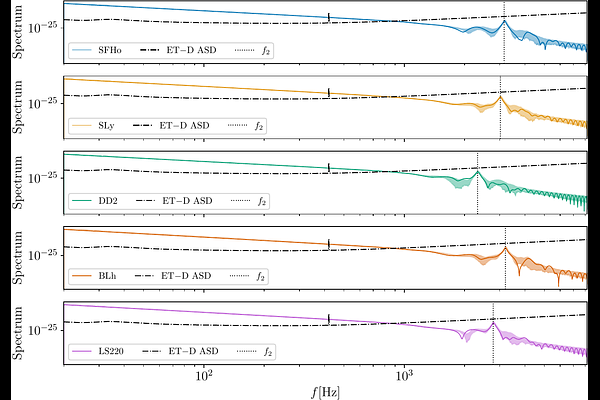Kilohertz Gravitational Waves from Binary Neutron Star Mergers: Full Spectrum Analyses and High-density Constraints on Neutron Star Matter

Kilohertz Gravitational Waves from Binary Neutron Star Mergers: Full Spectrum Analyses and High-density Constraints on Neutron Star Matter
Giulia Huez, Sebastiano Bernuzzi, Matteo Breschi, Rossella Gamba
AbstractWe demonstrate Bayesian analyses of the complete gravitational-wave spectrum of binary neutron star mergers events with the next-generation detector Einstein Telescope. Our mock analyses are performed for 20 different signals using the TEOBResumSPA_NRPMw waveform that models gravitational-waves from the inspiral to the postmerger phase. They are employed to validate a pipeline for neutron star's extreme matter constraints with prospective detections and under minimal hypotheses on the equation of state. The proposed analysis stack delivers inferences for the mass-radius curve, the mass dependence of the quadrupolar tidal polarizability parameter, the neutron star's maximum density, the maximum mass and the relative radius, and the pressure-density relation itself. We show that a single event at a signal-to-noise ratio close to the minimum threshold for postmerger detection is sufficient to tightly constrain all the above relations as well as quantities like the maximum mass (maximum density) to precision of ${\sim}6$% (${\sim}10$%) at 90% credibility level. We also revisit inferences of prompt black hole formation with full spectrum signals and find that the latter can be robustly identified, even when the postmerger is not detectable due to a low signal-to-noise ratio. New results on the impact of the initial signal frequency and of the detector configuration (triangular vs. two-L) on the source's parameters estimation are also reported. An improvement of approximately one order of magnitude in the precision of the chirp mass and mass ratio can be achieved by lowering the initial frequency from 20 Hz to 2 Hz. The two-L configuration shows instead significant improvements on the inference of the source declination, due to geographical separation of the two detectors.